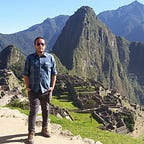Stone tool 3D Modeling: Biface
Undoubtedly, 3D modeling has become a new possible approach to cultural heritage. This tool provides not only a very accurate documentation resource, but also the opportunity to create a consistent and useful representation of the object or surface that is being analyzed. This makes this modern technique valuable for a wide range of disciplines.
In terms of archaeology, 3D modeling becomes particularly useful when it comes to surveying, as well as recording structures, artifacts and landscapes. Thus, archaeologists have started to consider 3D modeling as a useful approach to cultural heritage, and it could be included in their tool box (McCarthy, 2014).
This post briefly exposes the usage of this technique for archaeological materials. Particularly, it focuses on 3D modeling usage regarding artifacts, such as stone tools (Figure 1); as an example to pinpoint its value for the discipline.
Close Range 3D Modeling
Making 3D models from small objects is just one of the many possibilities that photogrammetry offers. Since there is a wide amount of fields and disciplines that can take advantage of all these digital tools. When it comes to archaeology specifically, close range 3D modeling can be use to create digital representations of artifacts. Therefore, it is an additional documentation resource while doing research or analysis.
Nowadays, taking photos of buildings, structures, crime scenes, soil work, objects, etc; has become a modern way to measure and model information. Likewise, some archaeologists have used their artifacts photos in order to create three-dimensional replicas (Photogrammetry, 2016). Allowing them a broader spectrum of analysis that can be made out of these models (e.g., comparative analysis).
In this case, a 3D model was created using a lithic artifact as example. Lithic refers to stone tools made by human beings, and they are one of the most common types of materials found in archaeological field work. The process was carried out making a model as accurate as possible from a replicative biface at the Museum of Texas Tech University.
The process started taking multiple overlapping photos of the biface, using a Nikon D7100 camera. A light tent was used to control the lighting into the image, and avoiding shades that could distort the model. The biface was moved in different positions along the process to capture a 360° perspective of the object. The most important aspect is to gather enough information in the images to recreate the whole shape of the object.
Once the photos have been taken, they were saved as RAW files (NEF Nikon). Then they were transformed into TIF files using Photoshop, in order to be compatible with Agisoft Photoscan which is the software that will develop the 3D model. Another important step that must be performed by Photoshop is masking each photo; this means that the biface will be highlighted within the photo file. The purpose of this step is to concentrate the information on the object.
After the masking process has been completed, the files can be opened on Photoscan to start developing the model. Once all images are align, then the program will create a point cloud and a dense cloud to start building the shape of the object.
The point cloud shows the information recorded on the photos and the common points to connect to each other. This allows the development of a dense cloud which exposes a closer look of the biface’s real shape (Figure 5). In this case, the controlled environment and the consistency of the images, provide a very accurate recreation of the object in terms of shape.
The final stages of the process consist on developing a solid view of the model (Figure 6), and adding texture into the model (Figure 7). Since these were closed range photos over a controlled environment, one can expect a high accuracy when it comes to features and details on the object’s texture. Therefore, this shows how useful 3D models can be to archaeology when it comes to documentation and interactive visualization of cultural heritage (Remondino et al., 2005).
Finally, a textured view of the model is the best representation that is shown on this case. As it shows shape, color, features and surface of the biface, allowing the researcher or observatory a closer look to the real texture of the object. Thus, a stone tool can be transformed from tangible material culture into digital heritage.
Conclusion
Although this model is just an example of the capabilities of this technique, it becomes clear the great utility and exploitation it brings into archaeology. Making 3D models from cultural material is not only an excellent mean to record and document patrimony, but also a step forward into creating a broader digital heritage.
This is not only a valuable resource in terms of research and analysis, but also a useful way to share this information with people and communities while protecting the object at the same time.
References
McCarthy, J., 2014. Multi-image photogrammetry as a practical tool for cultural heritage survey and community engagement. Journal of Archaeological Science 43, 175–185.
Photogrammetry, 2016. [Online] Available at: http://www.photogrammetry.com/ [Accessed on 30 Sep. 2016].
Remondino, F., Guarnieri, A. and Vettore, A., 2005. 3D modeling of close-range objects: photogrammetry or laser scanning? Proc. SPIE 5665, Videometrics VII, 216.
